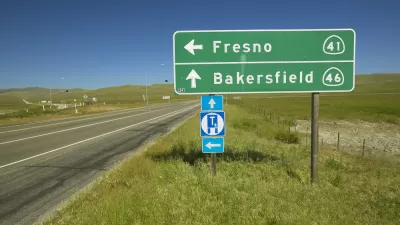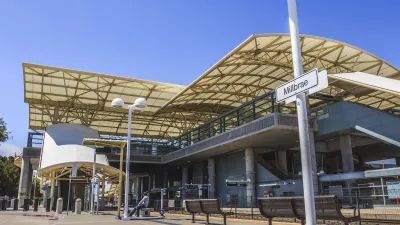With a train-friendly administration in Washington, supporters of the project hope that state leaders will make a stronger commitment to funding the full project.

California High-Speed Rail Authority (CASHRA) CEO Brian Kelly faced questions from state Assemblymembers in a joint hearing on March 10 as state leaders continue to debate the plan for building a 400-mile system connecting Southern California and the Bay Area via the Central Valley. As Melanie Curry reports in Streetsblog Cal, Kelly presented "the current business plan, which focuses on completing a usable 171-mile segment of electrified high-speed rail from Merced to Bakersfield," connecting some of California's fastest-growing cities.
With a more train-friendly administration in the White House, HSR supporters hope the project will benefit from federal funding that was withheld during the Trump administration. At the hearing, Louis Thompson, head of the High Speed Rail Peer Review Group, "urged the legislature to make a decision on whether it will commit to the project going forward," saying that the project "can never be managed without adequate and stable funding." In order to get the most out of the project, he said, the state has to show "ongoing commitment." Without a commitment to building the full system, warned Kelly, the state "will have spent $14 billion on a system that does not get you eighteen trips a day, that will be forced to share tracks with freight corridors, and will not bring an increase in ridership."
Since "the original bond funding was never meant to fully fund construction of a high-speed rail project from Los Angeles to San Francisco," writes Curry, it's time for the legislature to make concrete plans for securing the funding needed to build an effective HSR system.
FULL STORY: High-Speed Rail: It’s Time to Commit

Maui's Vacation Rental Debate Turns Ugly
Verbal attacks, misinformation campaigns and fistfights plague a high-stakes debate to convert thousands of vacation rentals into long-term housing.

Planetizen Federal Action Tracker
A weekly monitor of how Trump’s orders and actions are impacting planners and planning in America.

In Urban Planning, AI Prompting Could be the New Design Thinking
Creativity has long been key to great urban design. What if we see AI as our new creative partner?

Florida Seniors Face Rising Homelessness Risk
High housing costs are pushing more seniors, many of them on a fixed income, into homelessness.

Massachusetts Budget Helps Close MBTA Budget Gap
The budget signed by Gov. Maura Healey includes $470 million in MBTA funding for the next fiscal year.

Milwaukee Launches Vision Zero Plan
Seven years after the city signed its Complete Streets Policy, the city is doubling down on its efforts to eliminate traffic deaths.
Urban Design for Planners 1: Software Tools
This six-course series explores essential urban design concepts using open source software and equips planners with the tools they need to participate fully in the urban design process.
Planning for Universal Design
Learn the tools for implementing Universal Design in planning regulations.
Gallatin County Department of Planning & Community Development
Heyer Gruel & Associates PA
JM Goldson LLC
City of Camden Redevelopment Agency
City of Astoria
Transportation Research & Education Center (TREC) at Portland State University
Jefferson Parish Government
Camden Redevelopment Agency
City of Claremont





























